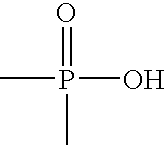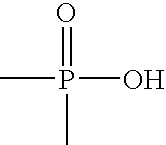Lithographic printing method and materials
a lithographic printing and material technology, applied in the field of lithographic printing methods, can solve the problems of inability to maintain the image area of the plate, and achieve the effect of increasing the abrasion resistance, and ensuring the stability of the pla
- Summary
- Abstract
- Description
- Claims
- Application Information
AI Technical Summary
Benefits of technology
Problems solved by technology
Method used
Image
Examples
example 1
Preparation of Conditioner Composition
CELVOL 502 poly(vinyl alcohol) (87-89% hydrolysis, viscosity of 5-6 centipoise for a 4% by weight aqueous solution, obtaine from Celanese Ltd.) was dissolved in water to make a 20% by weight solution. A mixture of 300 grams of the poly(vinyl alcohol) solution and 200 grams of ZINPOL 259 shellac emulsion from Noveon was maintained at room temperature while 500 grams of potable water was added to the mixture and the mixture stirred at room temperature for about five minutes.
example 2
Preparation of Conditioned Printing Plate
A Fuji FND plate was imaged using a negative. The FND plate was then placed into a Fuji PS-800HB plate processor using a developing time of 30 seconds, having the first bath of the two-bath process being an alkaline developer Fuji DN-5M and the second bath being tap water. The squeegee action of the plate processor left the plate dry to the touch after being developed.
The Conditioner Composition of Example 1 was applied to the plate using a cotton WEB-RIL wipe (a sheeted cotton ball wipe), and the plate was buffed lightly until dry.
example 3
Preparation of Conditioned Printing Plate
A Fuji FND plate was imaged using a negative. The FND plate was then placed into a Fuji PS-800HB plate processor using a developing time of 30 seconds, having the first bath of the two-bath process being an alkaline developer Fuji DN-5M and the second bath being the Conditioner Composition of Example 1. The Conditioner Composition on the plate was metered off with rollers, leaving a film dry to the touch.
PUM
| Property | Measurement | Unit |
|---|---|---|
| hydrophilicity | aaaaa | aaaaa |
| hydrophilic | aaaaa | aaaaa |
| areas | aaaaa | aaaaa |
Abstract
Description
Claims
Application Information
 Login to View More
Login to View More - R&D
- Intellectual Property
- Life Sciences
- Materials
- Tech Scout
- Unparalleled Data Quality
- Higher Quality Content
- 60% Fewer Hallucinations
Browse by: Latest US Patents, China's latest patents, Technical Efficacy Thesaurus, Application Domain, Technology Topic, Popular Technical Reports.
© 2025 PatSnap. All rights reserved.Legal|Privacy policy|Modern Slavery Act Transparency Statement|Sitemap|About US| Contact US: help@patsnap.com



